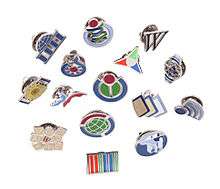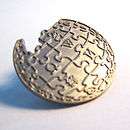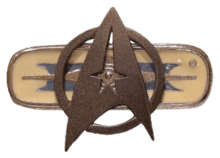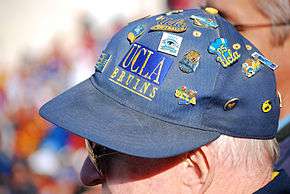Lapel pin

A lapel pin is a small pin worn on clothing, often worn on the lapel of a jacket. Lapel pins can be ornamental or can indicate wearer's affiliation with an organization or cause. Before the popularity of wearing lapel pins, boutonnières were worn.
Popular usage

Lapel pins are frequently used as symbols of achievement and belonging in different organizations. Lapel pins from the organization are often collected by members and non-members alike.
Businesses also use lapel pins to designate achievement and membership. Lapel pins are a common element of employee recognition programs, and they are presented to individuals as a symbol of an accomplishment.[1] Like fraternity and sorority pins, these lapel pins instill a sense of belonging to an elite group of performers at the organization. Businesses also award lapel pins to employees more frequently to boost employee morale, productivity and employee engagement.[2]
The Soviet Union had great production of these. Besides pins showing political figures and as souvenirs for tourist spots, there were pins for various sports, cultural, and political gatherings and for technical achievements of the Soviet Union. The pins had countercultural meanings as well; for example, the pin featuring the robot spacecraft Kosmos 186 (which approached and docked with Kosmos 188) had a sexual connotation.
In recent years, pin collecting and trading has also become a popular hobby. Demand for pin designs based on popular cartoon characters and themes such as Disney, Betty Boop, and Hard Rock Cafe has surged and led to the creation of pin trading events and other social activities. Disney pin trading is a prime example of this.[3]
Cultural significance


In the USSR and the People's Republic of China, the prominent lapel pins with portraits of Lenin and Mao Zedong, respectively, were worn by youth as well as by Communist party members or people who felt like showing their official political credo. In Czechoslovakia the Mao badges/pins were worn in the late 1960s and early 1970s by non-conformist youth as a prank and a way to provoke the "normalisationist" reactionaries of the purged post-1968 Communist Party of Czechoslovakia.
In the 1970s, initiates of Guru Maharaj Ji extensively used buttons, sometimes quite large, with images of the guru's face on them.[4][5]
Senior politicians in the UK's government, wore official Games pins for the London 2012 Summer Olympics.[6]
Design
Pin design starts off very similar to animation. Everything is literally hand drawn with a blue line. It is done either digitally or on paper with a light-box to plan out all of the elements and artwork that make up the design. Once the design is approved, it is inked, colored, and placed on a mechanical sheet, which is like a blueprint for the pin, with appropriate measurements and call-outs for manufacturing the parts.[7]
Process
Step 1: Stamping Molding
Molds the metal surface to form the design.
Step 2: Outline Cutting
- Cutting molds are made separately, then cut to the exact outline of the design.
- Additional outline cutting molds may be required depending on the complexity of the design. * If a center hole or cut-out is required, an additional cut-through mold must be used.
Step 3: Attachment
Solder attachment onto the back of each piece.
Step 4: Plating
Plating now can be processed. The quality of plating varies with the length of time the metal is soaked in the plating liquid.
Step 5: Polishing
The metal surface is then polished until it is smooth and shiny. This applies to copper material only. Iron can be polished if required, but this will incur a surcharge.
Step 6: Coloring
- Soft enamel is carefully inserted by hand, one color at a time, using different sized syringes. * Drying. * To prevent defects, a high degree of skill is required in order to keep each color and the correct amount of enamel in the proper area.
Step 7: Cleaning
Excess color and impurities are then wiped off the metal surfaces.
Step 8: Baking
The metal piece is baked at approximately 450F for12 to 15 minutes.
Step 9: Epoxy Coating
Clear epoxy is then applied to the surface to protect the enamel from color fading and cracking. (Epoxy coating is optional and provided according to customer’s requirements)
- The standard colors are based on the Pantone Chart.
- Bolder designs are recommended in order to prevent any unsatisfactory coloring caused by lines and figures that are too thin or too small.
- General enamel coloring requires a surrounding metal space to ensure good quality painting results. Therefore, it is usually necessary to allow for a blank metal rim (0.3mm minimum).
For budget considerations, iron material can be used instead of copper, but without polishing.
Modern manufacturing process

Almost all manufacturing is currently done in China, specifically in and around Kunshan, a satellite city in the greater Suzhou region that is administratively at the county-level in southeast Jiangsu, China, just outside Shanghai. Inexpensive labor in China has made non-Chinese production of lapel pins non-existent.
In the die struck manufacturing process there are five basic types of pins: cloisonné, soft enamel, photo etched, screen printed and 4-color printed.[8] In all processes, the outer shape of the pin is stamped out from a sheet of steel, aluminum, copper, brass or iron. In the case of cloisonne and soft enamel, the shape and the design are stamped out.
Cloisonné
Sometimes called epola or hard enamel, cloisonné is stamped out from a sheet of copper. The stamping leaves recessed areas, or pools, which are filled with enamel powder and high fired at 800 - 900 degrees.[9] After cooling, the surface of the pin is ground down to a smooth finish and then the copper is plated.
Soft enamel
This process is like epola and cloisonné in that strips of metal separate areas of color. Unlike cloisonné, the areas of color rest below the metal strip surface, which can be felt when you run your finger over the surface. Like the photo etched process, the top can be covered with protective epoxy[10] so that the piece appears smooth.
Photo etched
In the photo etch process, only the shape of the piece is stamped out. The design on the face of the pin, is chemically etched into the base metal, then color-filled by hand and baked before being polished. In the final step, a thin coat of clear epoxy can be applied to the surface.[11]
Photo Dome
This process begins by printing the art or design on vinyl or paper and then applying it to a metal pin base. The vinyl is then coated with an epoxy dome that protects the art from wear and the elements. This process is gaining in popularity because of advances in printing resolutions and the ability to complete these pins quickly in the United States.[12]
Screen printed
Screen printing, a.k.a. silk screening is produced by applying each color to the metal base using a "silk screen" process. These are blocks of solid color.[13] A very thin epoxy coat protects the color material from scratching.
4-Color process
4-colors process, a.k.a. offset printing, allows for bleeds and blends of colors, as is used in magazines. The colors are printed in the traditional CMYK process. This style is can be used for complex art and photo reproduction. An unlimited amount of colors can be used.[14]
Pin embellishments
- Pin on pin - A pin is riveted on top of another pin to give the design a 3-D look.
- Dangler pin - Dangle pins have an extension to the base of the pin that dangles (hangs) from one or more small loops or chains.
- Bobble pin - A bobble pin is an upside-down dangler pin that uses a spring instead of a chain.
- Flocking - A flocked pin has an area that is fuzzy.
- Lenticular pin - A Lenticular pin has two or more images that can change when it is tilted back and forth.
- LED pin - A LED is a Light-up pin that flashes when activated. The Light-up element has been used less in recent years due to difficulties in battery replacement and bulkiness.
- Slider pin - A Slider pin has a movable piece that slides back and forth across the base of a pin.
- Spinner Pin - A Spinner pin has a spinning mechanism that moves a piece of the pin 360 degrees.
Backside of the pin
The backside of a lapel pin can be just as important to as the front, not only because it holds the pin in place, but also because it may make the pin more unusual. Attachment pieces come in a variety of styles.[15]
- Butterfly clutch - One of the most popular modern methods of attaching pins is the butterfly clutch, sometimes called a military clutch. The back of the pin has a small prong attached and when the butterfly clutch is squeezed and pulled up from the prong the pin is released from the clutch. Butterfly clutches may be made out of metal, plastic, or rubber.
- Jewelry clutch - The jewelry clutch, or tie tack, is a simple but elegant design. The clutch locks into place when it covers the prong.
- Safety clasp - A safety clasp is similar to a safety pin in design. A long pin prong tucks under a small hook or clasp to hold the pin in place.
- Magnetic clasp - Magnetic clasps are composed of a small disc magnet that is attracted to another magnet that is attached to the back of the pin. Although this method is generally less secure, it is designed to prevent hole punctures in garments.
- Screw and nut - A screw and nut clasp is one of the most secure. The prong is threaded so that the nut screws into place to hold the pin firmly.
- Stick pin - A stick pin has a thin needle with a collar that slides up and down the needle to secure or release the pin.[16]
Additional markings

- Back Stamp - A pin's back stamp contains information about the pin and can include copyright information and edition size.
- Artist Proof - Artist Proof pins (or AP pins) are created during a manufacturing run to verify quality. AP pins have a small AP stamped on their back. Some collectors value the AP markings, but most AP pins have minimal difference in secondary value because the markings are not normally visible.
See also
| Wikimedia Commons has media related to Lapel pins. |
References
- ↑ "The Lapel Pin: The Real Story". June 2012.
- ↑ "Esurance Uses Lapel Pin Recognition to Boost Associate Morale"
- ↑ Pin collecting hobby
- ↑ Elman, Richard. "Godhead Hi-Jinx", Creem, March 1974
- ↑ Levine, Richard (March 14, 1974). "When The Lord of All The Universe Played Houston: Many are called but few show up", Rolling Stone Magazine, pp. 36–50. Also in Dahl, Shawn; Kahn, Ashley; George-Warren, Holly (1998). Rolling stone: the seventies. Boston: Little, Brown and Co, 102-105. ISBN 0-316-75914-7.
- ↑ Usborne, Simon (2012-07-18). "Pin doctors: The art of 'lapel politics'". London: The Independent. Retrieved 2013-02-27.
- ↑ Pin USA process
- ↑ "Custom Lapel Pins Style". The Pin People. Retrieved 2012-12-02.
- ↑ "Custom Products". Condor Creations. February 2009. Retrieved 2009-02-23.
- ↑ "Materials". Delta Spark. January 2008. Retrieved 2009-02-23.
- ↑ "Photo Etched Lapel pins". All About Pins. August 2008. Retrieved 2009-02-23.
- ↑ "Rush Pins". Pins Fast. Retrieved 2012-03-17.
- ↑ "Silk Screen Printed Lapel pins". Lapel Pin Express. 2008-08-01. Retrieved 2009-02-23.
- ↑ "Printed Lapel Pins". Kunshan Huain Lapel Pins. 2009-01-05. Retrieved 2009-02-23.
- ↑ Pins Clasps http://pins.com/support-m/pin-clasps
- ↑ How lapel pins are made
